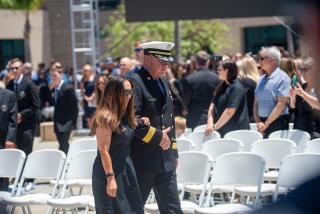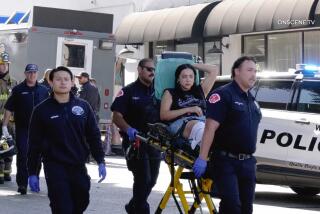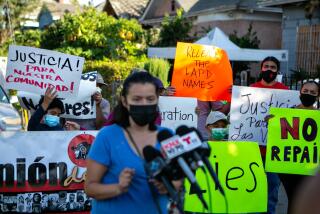Tunnel Explosion Injures 3 Welders : Subway: A chunk of metal rips through acetylene tank to touch off blast. Injuries to workers may be the worst since project began. A state safety investigation is under way.
- Share via
Two subway construction workers were critically injured and a third was seriously hurt Monday when a welding-related explosion rocked a tunnel beneath Vermont Avenue and 6th Street.
Smoke from the midday blast billowed out of vents above the construction for a distance of five blocks, according to city Fire Department officials. Firefighters said that a resulting flash fire in the concrete-and-steel tunnel was quickly doused by employees of the contractor, Shea-Kiewit-Kenny.
The two most seriously injured workers were identified as Dale Gibson, 37, and Andy Gutierrez, 52, both of whom were treated at area hospitals before being transferred to the burn unit at Torrance Memorial Hospital. Gibson, who was hoisted out of the construction in a wire cot, was listed in critical condition with third-degree burns over 80% of his body, a fractured leg and smoke inhalation. Gutierrez was listed in serious condition with burns on 30% to 35% of his body.
The third victim, Michael Willis, was treated for smoke inhalation and was listed in stable condition at Queen of Angels Hollywood Presbyterian Medical Center. Willis, who was undergoing tests on Monday evening, Gutierrez and Gibson are welders employed by Kiewit Construction Co. of Omaha.
Officials said the blast was caused by a three-inch-wide chunk of metal that fell from a conveyor belt and pierced a tank of acetylene, a highly flammable substance used to power welding torches for heavy construction. Workers accidentally cut the metal chunk while disassembling the conveyor belt, said Deputy Fire Chief Don Anthony.
He said that workers believed the metal chunk was connected to another portion of the equipment and would not fall.
The acetylene is combined with pure oxygen during the heavy welding. In this instance, Metropolitan Transportation Authority officials said the tanks were being used in connection with welding efforts to salvage portions of a tunnel-boring machine, known as a shield. The acetylene and oxygen are kept in side-by-side steel containers that stand about four feet tall and are 10 inches to 15 inches in diameter.
Assistant City Fire Chief Robert Neamy said the blast occurred about 1:43 p.m., during a shift change. He said inspectors would comb the site to check for related damage. The blast also came under immediate investigation by the occupation-safety unit of the state labor department.
“We will make a complete investigation,” said Robert Garcia, regional manager of the department’s Division of Occupational Safety and Health.
Representatives of the contractor, a joint venture led by the J. F. Shea construction company, declined to comment and referred all questions to other Metro Rail officials.
Monday’s accident was the latest safety problem to beset Shea-Kiewit-Kenny. On March 15, a tunnel superintendent and two other workers were hospitalized when a rail-construction car went out of control and derailed. The accident and earlier alleged safety deficiencies prompted officials to shut down the tunneling operations during March and part of April.
In a letter to Shea-Kiewit-Kenny, a Metro Rail safety official described the March 15 accident as the latest example of “your ongoing unacceptable safety and quality performance on this project.”
In addition to the three welders who received major injuries Monday, other workers ran or walked nearly three miles to exit the tunnel at a portal at Barnsdall Park, near Hollywood Boulevard and Vermont. The tunnel is one of two, side by side, that eventually will link Hollywood and Wilshire boulevards.
Two other workers stayed behind and extinguished the remains of the flash fire with eight chemical fire extinguishers, according to city firefighters.
“There wasn’t that much smoke when we got here,” said city Firefighter Dave Holcomb, one of the first on the scene. “It probably was just a flash and it was over.”
From October, 1991, through May of this year, the Shea-Kiewit-Kenny construction has experienced nine injuries that kept people out of work the next day and a total of 149 requiring medical treatment, according to Andrea Greene, an MTA spokeswoman. She said those rates are half the national average.
The injuries resulting from the explosion Monday were believed to be the most serious since construction began on the Los Angeles subway. “This could be the worst one yet,” said Ronald N. Tutor, whose Tutor-Saliba Corp. has constructed most of the tunnels. “It’s a risky business.”
The search for possible victims took three hours because firefighters had to comb two tunnels 14,000 feet long between Barnsdall Park and the corner of Wilshire and Vermont. At first they thought it was much worse. LAPD called a tactical alert, and the Fire Department sent 33 engine companies.
Several buildings in the area were evacuated, including the Denny’s restaurant on Vermont.
Subway Blast
Three workers were injured Monday by an explosion in an unfinished segment of the Metro Rail Red Line. Other workers in the tunnel had to exit at a portal near Barnsdall Park. Times staff writer Nora Zamichow contributed to this article.
More to Read
Sign up for Essential California
The most important California stories and recommendations in your inbox every morning.
You may occasionally receive promotional content from the Los Angeles Times.















